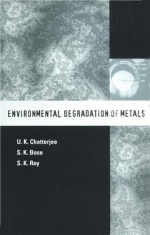Tab Article
Environmental Degradation of Metals describes the effects of atmospheric exposure, high-temperature gases, soil, water, weak and strong chemical, liquid metals, and nuclear radiation...determines whether corrosion can occur under a given set of condition....shows how improvements in component design can reduce corrosion....details the high- and low-temperature effects of oxidizing agents, such as oxygen, sulfur and water vapor, the halogens, and CO2....investigates the instantaneous and delayed failure of solid metal in contact with liquid metal....highlights the influence of hydrogen on metal, including the loss of ductility and internal flaking, blistering, fissuring, and cracking....profiles radiation effects on metals, such as irradiation growth, void swelling, and embrittlement...and more.
With key references, tables, and drawings, Environmental Degradation of Metals is suitable for mechanical, corrosion, maintenance, metallurgical, materials, chemical, aerospace, manufacturing, industrial, nuclear, plant, project, construction, industrial, civil, environmental, design, process, product development, and packaging engineers; materials scientists; surface chemists; applied physicists; architects.


